Living the Dance
Lightsey Darst reflects on the phenomenon of performance as museum piece, in particular this fall's dance/visual art installation by Eiko and Koma at the Walker, with a brief notation on Laurie Van Wieren's retrospective, "Who Made These Videotapes?"

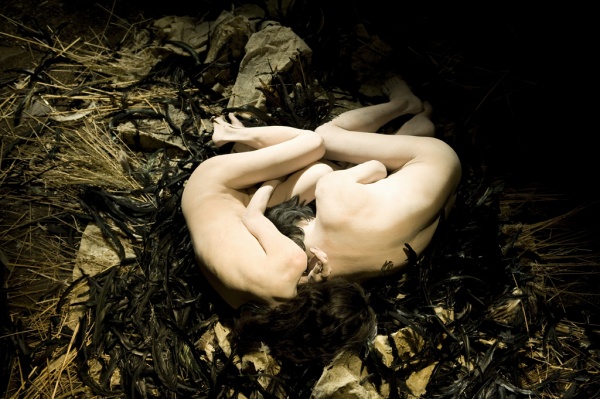
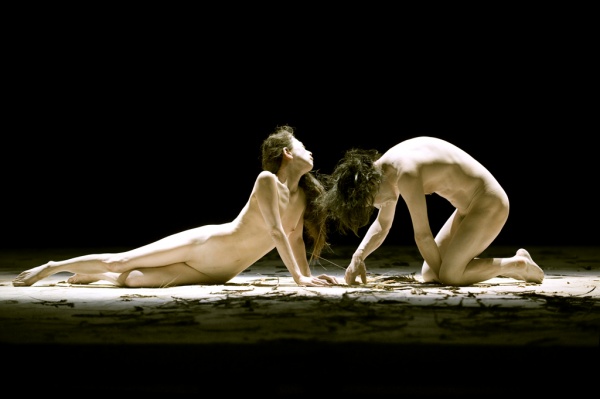
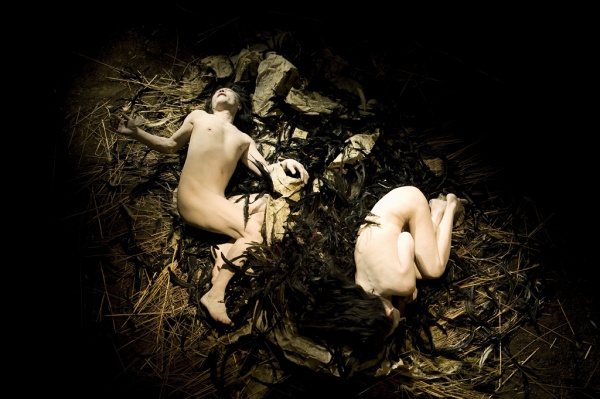
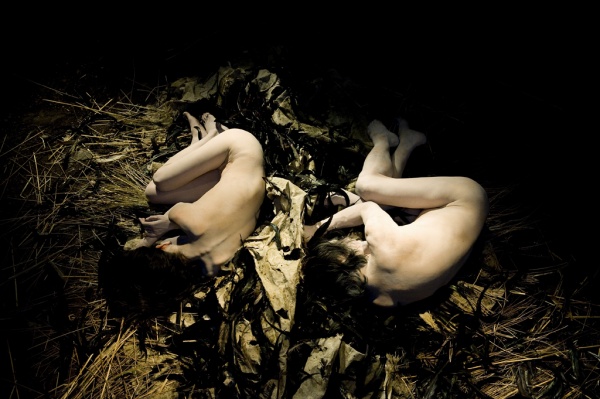
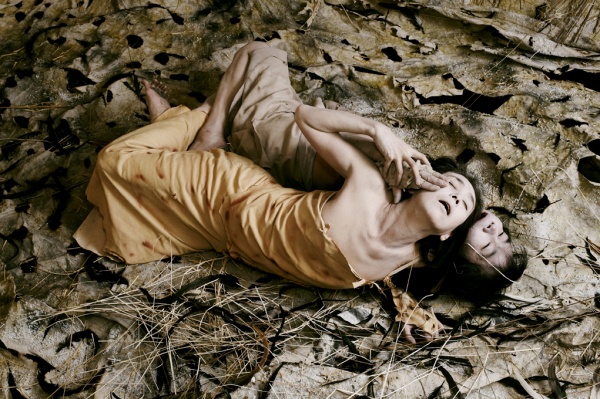
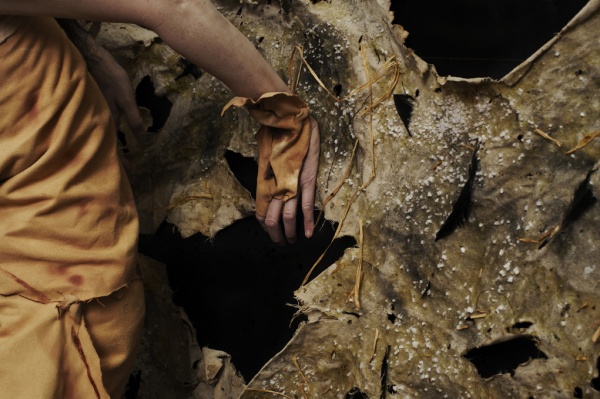
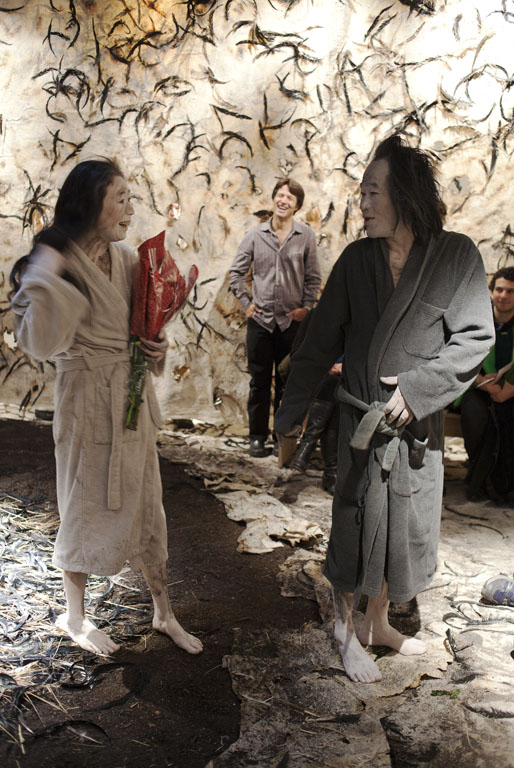
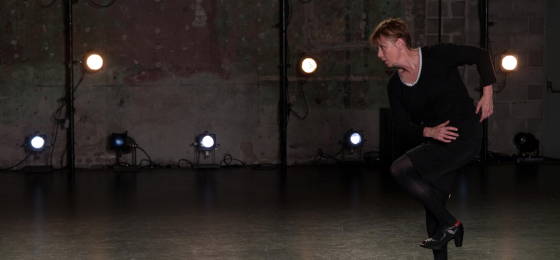

THE MAN AND WOMAN LIE IN A HEAP of long black feathers, salt, dirt, and other organic detritus, naked, their bodies painted grey-white and daubed with dirt. The light — amber, pooling — fades and dawns as they gradually shift like sleepers, their hands reaching, opening, closing, rolling themselves slowly over so now her shallow side dimly glows under the light, now his curving rear. They’ve made themselves a rectangular sleep-enclosure of heavy canvas daubed with glue and salt, smeared with raven feathers, seared and burned through here and there. In their cave, water drips from the ceiling into the dirt; it’s the only sound.
You sit on one of three benches inside the enclosure, with other clothed, upright, curious museum visitors, less than ten feet from the performers; or, you peer through the peepholes in the canvas, spying them curled there like early humans in a museum diorama, perhaps resting after devouring a giant bird. You choose where you’ll sit or stand, whether you’ll whisper to your companion or remain churchily silent. And you watch the naked people lying on the ground before you. You give them five minutes, or half an hour; they aren’t going anywhere, but maybe you are.
Eiko and Koma’s Naked, a dance installation that occupied a corner of a gallery in the Walker’s Event Horizon exhibition for most of November, is the sort of work whose tensions are instantly graspable. You could pop in, make some notes (notions of life and time, anthropology, nudity, voyeurism, the museum, etc), and write your PhD. Anything else you might get in a longer visit is ephemera, really — personal observations that float off when you try to pin them down, and that don’t amount to a larger point.
Of course, you could say the same thing of a 40-year marriage. What could anyone tell you that you can’t readily intuit from the outside? And yet, over time, the experience of this work is radically different; the ephemera accrue and change the light you live in.
*****
So, without further ado, some fleeting thoughts.
My first time at Naked, I was consumed with practical concerns. I was the only person in the enclosure at first, and I had the impression they’d just sprung to life when I came in; was that true? When no one was around, did they go on as if someone were? Did they talk to each other? And I wondered about bathroom breaks in their eleven-to-five (museum hours) stint. That question, anyway, was resolved when a guard came in and told everyone the artists would be taking a short break. Still, the question of just how they took that break lingered. Did they get up and walk off? At the end of the day, too, did they drop “the act,” get their street clothes and their lunch pails, and punch out with everyone else coming off shift?
There’s something incongruous about dancers, artists, being tied to a 9-to-5 (ish) schedule. At first glance, you might connect Naked to the 24-hour living vitrines performance artists sometimes inhabit, but really, Naked is just the opposite. Where 24 hours screams all artist, all the time, 11-to-5 says artist on the clock. It’s strangely blue-collar. (And I’d argue that the fact that Eiko and Koma are costumed and mostly not looking back also makes this strikingly different than Marina Abramovic’s recent The Artist is Present.) I was told that, on the last day, the lights went out and the artists wrapped themselves in robes; then the lights came back on, the artists took a bow, and everyone applauded, just as usually happens in performance. But most of the time they were at your service.
People have said a lot about Eiko and Koma‘s slow movement. At least, that’s the usual way to describe it: slo-mo, glacially slow, etc. But “slow” isn’t the word I would use, exactly; “incremental” might be more accurate. Their movement — that gradual roll, the abortive grasping — reminded me of Zeno’s paradox, in which you realize that to get anywhere, you must first go half the distance there, then half the remaining distance, then half again, and so on into infinity, which means that, since you cannot do an infinite number of things in a finite amount of time, you will never get there. Eiko and Koma’s movement is grainy like that, in a way that sometimes seems to reference human fallibility (we can only chop the muscular impulse so fine), sometimes the structure of the universe (visible objects break down to atoms break down to quarks in a discontinuous hierarchy of matter). Life and time are like this, too, when you look closely: not riverine, flowing, but stopping and leaping, like sand in an hourglass.
Voyeurism: It’s one thing to talk about it, quite another to sit there and practice it. And yes, we are always watching and being watched, got it, but I’m talking about sitting eight feet from two naked people, watching them with a bunch of other warmly-dressed museum-goers, some of whom are peering in from spyholes in the canvas curtains around the installation. Sitting there on my second visit, I began to have the desire to protect the performers from the gazes, or at least from one gaze, my own. So, I looked at the curtain, at the floor, at the other spectators. I put my hand in the dirt. I wanted to be gentle.
What brought on this wave of concern was a little boy whose first impulse was to walk to the very edge of the dirt and stand there leaning slightly forward, looking down at Eiko and Koma. Had he been a grown man, you would have said he was standing over them; this little boy appeared to me to be reveling in all the dominance implied in that phrase. Adults – naked — and I can just look at them! The next stage, I imagined, would be poking them with a stick.
Perhaps I’m falling a little too far on the nasty and brutish side. The boy and his mother were clearly having a fun day at the museum, whispering together, looking from different angles. And on another day I had fun peering into the diorama from outside, trying the different peepholes (low ones, high ones), treasuring the intimacy of a view only I could have.
One more note on the subject: I noticed that when I used the peepholes, I found myself leading a wave of peeping toms. Everyone enjoys it, apparently, but no one wants to be the first to spy.
________________________________________________________
Dance as thing, performance as acquirable, collectible — it’s a hot notion now (see Tino Sehgal, Marina Abramovic). You can play with this intellectual puzzle if you like, but living it is different: poignant, troubling.
________________________________________________________
Rules and rule-breaking: Isn’t it strange how keen we are to figure out the rules to every encounter or scenario? You watch them a bit and think, “They’re never going to touch each other,” but then they do — glancingly, half-unconsciously, but it’s contact still. Or, you think (with a little relief), “There’s a wall here — they’re not going to look at me,” and then Eiko makes eye contact with you — no expression on her face, but still, she sees you.
Isn’t it funny how rule-breaking takes the form of contact?
*****
Several times I had the sacrilegious thought, “What are these world-famous artists doing wasting a month of their lives in a Midwestern museum?” I wondered whether the casual experiences of visitors — passing through, looking in, moving on — justified the expense of life and energy. Naturally this economic cost-benefit talk is open to critique (see PhD crack above), but even fair critique of the point doesn’t change the fact that human life is a limited resource, a fact brought home by the seeming decay of the installation, the trickling water, the dirt, the disarray, and by Eiko and Koma’s apparent age (trim and supple as they are, they’re clearly past youth). I say “seeming decay” because, actually, the installation didn’t change over the course of the month — a conscious decision Eiko and Koma made, I was told, to insure that all visitors received an equal experience. Still (or even more so), what a long month it must have seemed to them, lying on the floor in the salt and dirt, moving ever so gradually, not speaking, the same thing day after day, 11 to five.
On the other hand… When I first heard the installation would be at the Walker for a month, I thought, “Oh, I can go a bunch of times!” I went once, early on, and then suddenly time was winding down, and I crammed in two more visits before the close. What happened to that month? The answer is: life, all the usual activities that prevent my noticing the passage of time. So, who wasted a month of life here, and what would that even mean, to waste life?
One final thought, now, about dance as installation: I’ve just seen and participated in another, quite different installation: Laurie Van Wieren‘s Who Made These Videotapes? I live-blogged before and during the performance; I’ll refer you to the mnartists.org blog for details of Van Wieren’s work. Different as they are, both these performances situate dance as a potential museum object, and both highlight the contradictions of such a situation. Dance as thing, performance as acquirable, collectible — it’s a hot notion now (see Tino Sehgal, Marina Abramovic). You can play with this intellectual puzzle, if you like (PhD, anyone?), but living it is different: poignant, troubling. What installations do to conventional art objects is (often) make them more alive. The installation’s physical awkwardness gives it a life span; while it’s before you, you know, even if it’s remounted, it’ll never look quite like this again. But with dance, already so alive, what an installation does is make it more permanent, or to put it glass-half-emptily, more dead. At the same time that the installation slows dance’s mayfly lifespan, it somehow also casts on the viewer more than the usual obligation to remember this. A performance can feel celebratory: one vivid night and out. But an installation shames the casual viewer, reminds you of what is always true: you will never be able to do justice to this gift of passing life.
________________________________________________________
________________________________________________________
Noted events and information:
Naked, a dance/visual art installation by Eiko & Koma, was on view at the Walker Art Center November 2 – 30, 2010.
Laurie Van Wieren’s recent performance/installation retrospective, Who Made These Videotapes?, was at the Bryant Lake Bowl in Minneapolis December 9, 10 & 14, 2010.
Lightsey Darst’s live-blogging from Van Wieren’s performance, presented on the mnartists.org blog, can be found here. Her post-show reflections, written the day after the performance, are here.
________________________________________________________
About the author: Originally from Tallahassee, Lightsey Darst is a poet, dance writer, and adjunct instructor at various Twin Cities colleges. Her manuscript Find the Girl has just been published by Coffee House; she has also been awarded a 2007 NEA Fellowship. She hosts the writing salon, “The Works.”